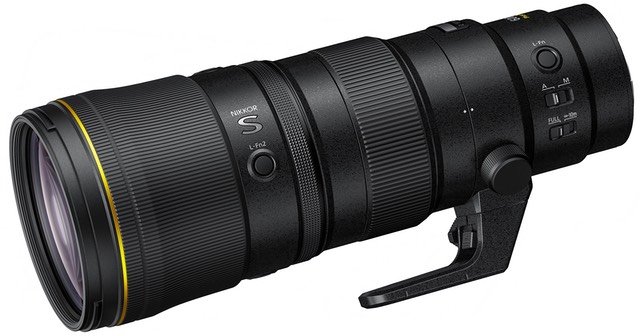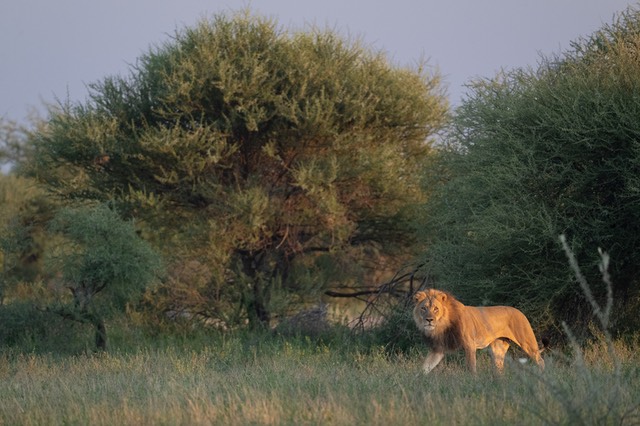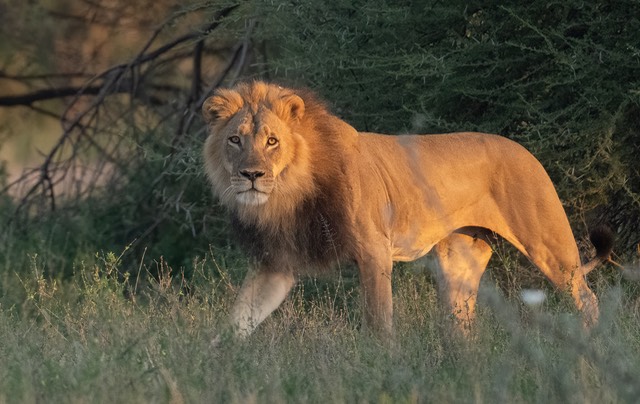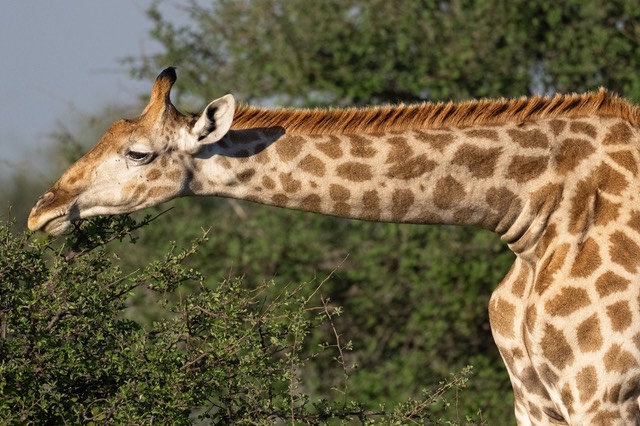
What is It?
The 600mm f/6.3 PF VR lens is another in Nikon's ongoing efforts to fill out a strong telephoto lens lineup in the Z System. It's interesting that 400/600/800 is the new primary focal length targets in the Z System, with 300mm and 500mm being skipped for now.
With this lens we now have three ways to get directly to 600mm:
- 180-600mm f/5.6-6.3 VR — US$1700
- 600mm f/6.3 PF VR S (reviewed lens) — US$4300
- 600mm f/4 TC VR S — US$15,500
That's a pretty wide price range for the focal length. I've already reviewed the 180-600mm f/5.6-6.3 VR and given it a Recommended rating, so what's different about the 600mm f/6.3 PF VR S that makes it worth more?
First up is size and weight. Surprisingly the 600mm f/6.3 PF VR S is 23.3 ounces (660g) lighter than the 180-600mm f/5.6-6.3 VR. It's also 2" (51mm) shorter (though a little wider in diameter, with the now common 95mm front filter thread). This makes the lens both easier to carry when hiking, but also much more pack friendly. Yes, you give up the zoom flexibility, but if you're always at the long end—as birder's usually are—this is a significant size and weight reduction that gets appreciated quickly.
A reversible lens hood bayonets up front, and has a rubber front edge. The lens itself is weather sealed throughout, including a rubber gasket at the lens mount.
Inside the lens we've got 21 elements in 14 groups. The big news is that one of the primary big elements is a phase fresnel (PF) element, which is one of the weight/size reducers. Three of the other elements are low dispersion. The 600mm f/6.3 PF VR S also has Arneo coating to reduce flare and ghosting, as well as a fluorine coat on the front element to keep dust and water from sticking.
The lens has built-in VR, and this produces 5.5 stops of CIPA-defined benefit (6 stops if the camera supports Synchro-VR, such as the Zf, Z8, and Z9). Be careful in relying upon CIPA numbers, though, as they are produced on a shake table that doesn't exactly mimic human motion. I'd tend to say that I can handhold the 600mm f/6.3 PF VR S at something closer to three stops lower with VR than I can without it and get consistent results.
One of the few drawbacks of the lens is the 12.8 foot (3.9m) close focus distance and produces a mediocre 1:6.1 maximum reproduction ratio, the worst of the 600mm options (180-600mm is 1:3.9, the 600mm f/4 TC VR S is 1:4.7 with TC engaged). Some birders, particularly those approaching small birds or using hides, may find this a bit on the limiting side.
On the flip side, one of the benefits of the 600mm f/6.3 PF VR S over the 180-600mm f/5.6-6.3 VR has to do with additional control functions. The 600mm f/6.3 PF VR S has four L-Fn2 buttons, one L-Fn button, and a Memset button, in addition to a focus limiter switch and extra control ring.
Nikon's usual detachable tripod foot comes with the lens, but it's pretty useless in two respects: it doesn't have an Arca-Swiss compatible plate and it's really short, so doesn't make for comfortably carrying the lens via the foot.
The 600mm f/6.3 PF VR S sells for US$4800, and is made in China.
Source of the reviewed lens: purchased via NPS Priority Purchase (plus I used two other samples I borrowed briefly)
How's it Handle?
Lighter and smaller is interesting at really long focal lengths. You'll have both clear benefits as well as some drawbacks. The benefit is that you can manage this lens while hiking, walking, or photographing out of vehicles much better than you can a heavier, larger lens. However, at the same time you've got a lot of focal length without a lot of mass, so you have to be careful that you're holding it steady.
I know some of you are looking at the CIPA VR numbers and applying old rules of thumb and thinking "I can handhold this lens at 1/30 of a second" (1/1000 dropped 5 stops). I'm pretty sure you can't. You don't have a lot of mass that's helping you stay steady. Don't fall into the trap of using slower shutter speeds because you think VR will rescue you.
But the real handling issues are the typical ones on Nikon telephotos these days: strange control positions and that silly, inconvenient tripod foot (note the top image on NikonUSA's Web site and the awkward way the user is holding the lens ;~). On the 600mm f/6.3 PF VR S, these two intersect: the focus ring is at the same position as the foot, making it tougher to do small rolls of manual focus unless you rotate the foot out of the way. You can, of course, put focus on the extra control ring, but then you lose a programmable option some might want. Coupled with the poor position of the L-Fn button, the "extra" controls on the 600mm f/6.3 PF VR S start becoming less desirable.
Moreover, it seems like every telephoto lens design Nikon is producing simply doesn't go through a UX/UI review. The design engineers appear free to place controls wherever it suits the mechanical design best, without regard to actual use. It's clear none of the design team actually uses these lenses.
How's it Perform?
Focus: Clear focus breathing can be seen on a full focus pull from near to far, approaching 20% total. This is clearly worse than the 180-600mm f/5.6-6.3 VR under the same conditions, even though the zoom focuses closer.
In terms of focus speed and accuracy, the 600mm f/6.3 PF VR S is as fast and accurate as you'd expect from a (near) exotic. I had no issues with quickly locking and tracking focus, even in fairly dim light.

I've taken to trying to show animals in their natural environment more, so actually had to back away from this early-morning lion, particularly since the other two in the vehicle also had 600mm lenses at the time (one 180-600mm, the other 600mm f/4 TC).

But even at 100% view the lion shows remarkable detail and the focus stayed locked. The character of this shot doesn't have the focus isolation of the 600mm f/4 TC VR S image, but the falloff and background bokeh is clearly better than what the 180-600mm f/5.6-6.3 VR produced.
Sharpness: Nikon's published MTF figures for the 600mm f/6.3 PF VR S look basically like a flat line, with nominal reduction of contrast over any portion of the frame. The lens pretty much performs to that expected level. Wide open the center is excellent-, the DX boundary is also excellent-, and the FX corners are still in what I'd call very good+. That's a remarkably strong edge to edge performance. Things improve by stopping down to f/8 (center excellent).
The tested lens is better at 600mm f/6.3 than my excellent 180-600mm f/5.6-6.3 VR sample. But the 600mm f/4 TC VR S does better in the center of the frame (a clear excellent+), while being perhaps a bit better as you move away from the center. We now have three strong ways to get to 600mm, and they orient exactly as you'd guess from their pricing: 180-600 is the weakest, 600mm PF is better, and the 600mm f/4 TC VR S takes top marks.

Coma is very well controlled, with only a very minor bit of PF edge smear on point sources. I did not detect any meaningful difference at close focus distance versus infinity in terms of sharpness.

With the 1.4x teleconverter, everything goes down a notch on the 600mm f/6.3 PF VR S, to perhaps very good- across the board, and the PF remains better than the 180-600mm with teleconverter, but behind the 600mm f/4 TC VR S with it's teleconverter in place. Using the 2x teleconverter takes it down a strong bit, to perhaps good in the center, fair outside the center. It's unclear how much of this is due to diffraction impacts versus any optical degrading due to the teleconverter, though. If you need 1200mm, the 600mm f/4 TC VR S is the clear choice.
Update: I was asked about some specific comparisons, so here they are:
- 500mm f/5.6E PF VR versus 600mm f/6.3 PF VR S: this would probably be an ever so slight win optically for the older 500mm if it weren't for the fact that you've added a mount to use it on the Z bodies. But we'd be nitpicking for the most part on optical differences; both are excellent lenses. The real issue is with teleconverter use: the Z-mount teleconverters are better with the Z-mount lenses than the F-mount ones are with the F lenses, plus adding a triple mount coupling to use a teleconverter with the 500mm f/5.6E PF VR is asking for AF Fine Tuning, best case. If you aren't using teleconverters, pick either lens. If you plan to regularly use teleconverters, pick the 600mm f/6.3 PF VR S.
- 400mm f/4.5 VR S versus 600mm f/6.3 PF VR S: Here we have a different story. The minute you add the teleconverter to the 400 to get close to the same focal length (560mm), you've changed the optics equation. The 400mm is better optically than the 600mm barebones at its base focal length, but it isn't as good as the 600mm at 560mm with the 1.4x teleconverter. I still consider the 400mm f/4.5 to be the long lens of choice for most people, as long as they're not always photographing with a teleconverter on it. The teleconverter on the 400mm should be considered an emergency extension to get more reach, not something you rely on—e.g. on the lens most of the time—if you're looking for best possible results.
Vignetting: I'm not sure that the lens reaches a full stop of vignetting without the controls in place, though there is a fairly narrow area in the center that is free from vignetting. It takes to f/11 to clear this minor vignetting to the level of ignorable. The in-camera corrections manage to make even wide vignetting ignorable. If you want to take vignetting fully out, set the camera's control to High instead of Normal.
Linear Distortion: Almost undetectable and very regular pin cushion. Moreover, the in camera controls can reduce this to essentially zero.
Chromatic Aberration: Remarkably low chromatic aberration, both in the longitudinal and lateral directions. For all intents and purposes, none that you'll need to correct.
Flare: As with all PF lenses, you need to be careful of light sources in the frame. You'll get a clear area of circular flare around the light source, and it's very difficult to correct for. The 600mm f/6.3 PF VR S should be used with care in sports settings, where backlight sources can be in the field of view, but for wildlife photography, this isn't an issue.
Bokeh: Not great but not close to terrible, either. The primary issues are a strong edge rim on out of focus highlights coupled with clear shading that renders circles as ugly near ellipses that happens even before the DX corner. By the FX corner, we have clear cats eye with some clear points on the ellipse edges. Onion skinning is present, but low in visibility, which is a little surprising for a lens with a PF element. I will say that when onion skinning begins to appear, it's most noticeable at the very center of highlight, which is likely the PF element being rendered; the remainder of the highlight bubble tends towards leopard spots rather than onion skin, and that's not usually visible.
Final Words
If you're looking for the best 600mm, the f/4 TC VR S is the clear choice, not only because of a slightly stronger sharpness level, but because the out of focus areas can be better controlled and look free-er of artifacts. However, you pay a big price (literally) for all that goodness. If on the other hand you're looking for the least expensive way to 600mm, the 180-600mm f/5.6-6.3 VR is a really good choice, even though it doesn't quite match the lens being reviewed here.
Thus, we're in a goldilocks situation, particularly when it comes to your pocketbook: to do better you have to spend way, way more. You can save money, but you get a bit less performance, plus end up with a longer and heavier lens. The 600mm f/6.3 PF VR S sits right in a sweet spot, thus it's not difficult to recommend.
You'll want to replace the tripod foot, and pay some attention to how you customize the lens controls for best use, but I doubt you'll be disappointed by the optical results with this lens.
Recommended (2024 to present)
Support this site by purchasing from the following advertiser:
